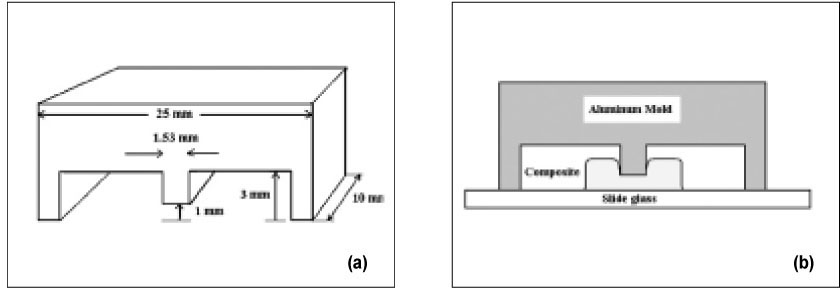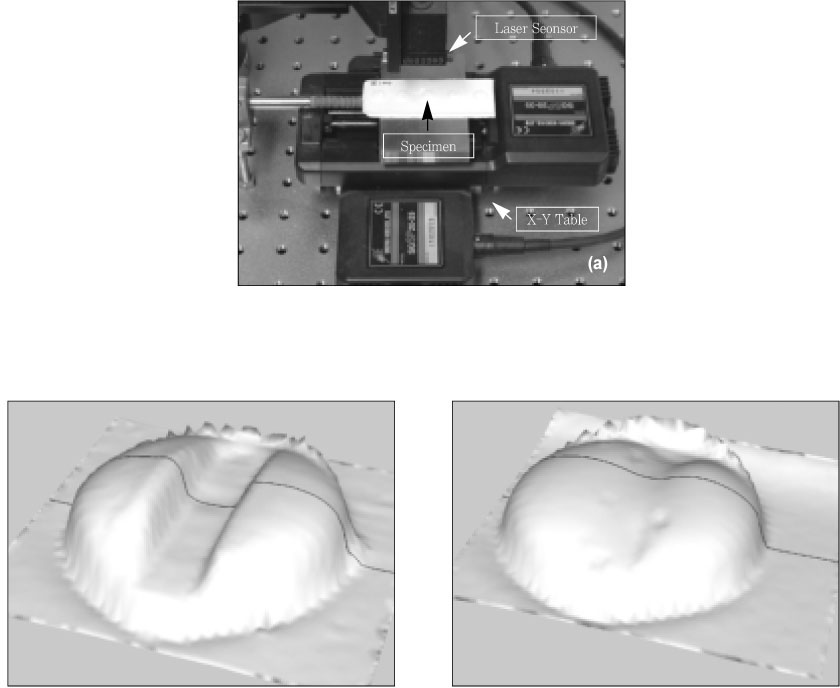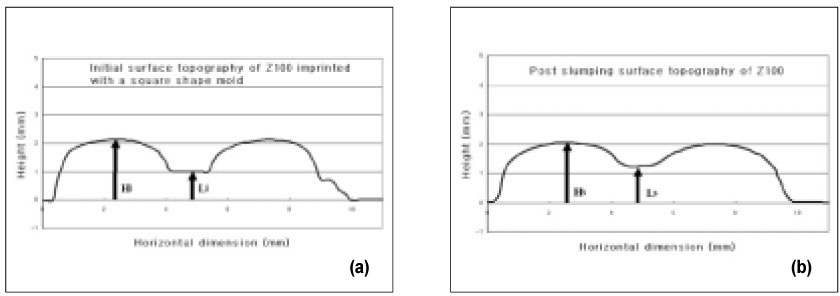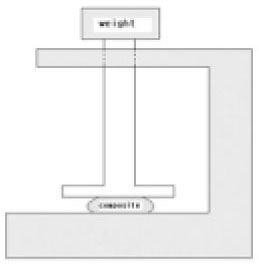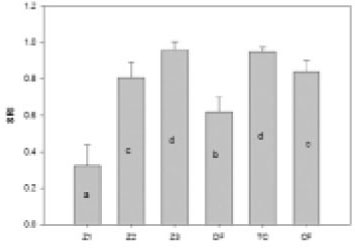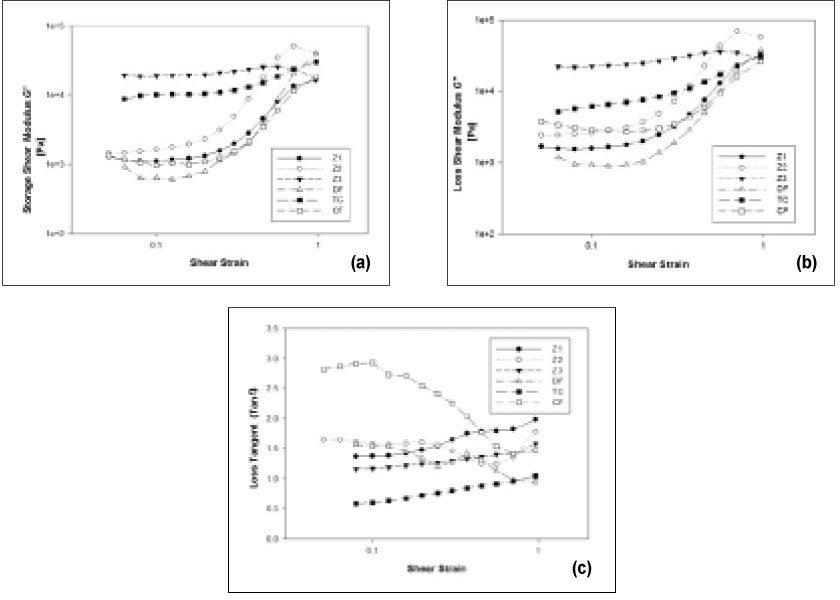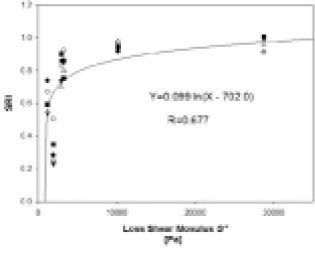J Korean Acad Conserv Dent.
2008 May;33(3):235-245. 10.5395/JKACD.2008.33.3.235.
Slumping resistance and viscoelasticity of resin composite pastes
- Affiliations
-
- 1Department of Conservative Dentistry, School of Dentistry, Seoul National University, Korea. inboglee@snu.ac.kr
- KMID: 2175986
- DOI: http://doi.org/10.5395/JKACD.2008.33.3.235
Abstract
- The aim of this study was to develop a method for measuring the slumping resistance of resin composites and to relate it to the rheological characteristics. Five commercial hybrid composites (Z100, Z250, DenFil, Tetric Ceram, ClearFil) and a nanofill composite (Z350) were used to make disc-shaped specimens of 2 mm thickness. An aluminum mold with square shaped cutting surface was pressed onto the composite discs to make standardized imprints. The imprints were light-cured either immediately (non-slumped) or after waiting for 3 minutes at 25degrees C (slumped). White stone replicas were made and then scanned for topography using a laser 3-D profilometer. Slumping resistance index (SRI) was defined as the ratio of the groove depth of the slumped specimen to that of the non-slumped specimen. The pre-cure viscoelasticity of each composite was evaluated by an oscillatory shear test and normal stress was measured by a squeeze test using a rheometer. Flow test was also performed using a flow tester. Correlation analysis was performed to investigate the relationship between the viscoelastic properties and the SRI. SRI varied between the six materials (Z100 < DenFil < Z250 < ClearFil < Tetric Ceram < Z350). The SRI was strongly correlated with the viscous (loss) shear modulus G' but not with the loss tangent. Also, slumping resistance was more closely related to the resistance to shear flow than to the normal stress. Slumping tendency could be quantified using the imprint method and SRI. The index may be applicable to evaluate the clinical handling characteristics of composites.
MeSH Terms
Figure
Cited by 1 articles
-
The change of the initial dynamic visco-elastic modulus of composite resins during light polymerization
Min-Ho Kim, In-Bog Lee
J Korean Acad Conserv Dent. 2009;34(5):450-459. doi: 10.5395/JKACD.2009.34.5.450.
Reference
-
1. Al-Sharaa KA, Watts DC. Stickiness prior to setting of some light cured resin composites. Dent Mater. 2003. 19:182–187.2. Lee IB, Son HH, Um CM. Rheological properties of flowable, conventional hybrid, and condensable composite resins. Dent Mater. 2003. 19:298–307.
Article3. Craig RG, Powers JM. Restorative dental materials. 2002. 11th Ed. Mosby Co.;91–98. 231–251.4. Bayne SC, Thompson JY, Swift EJ, Stamatiades P, Wilkerson M. A characterization of first-generation flowable composites. J Am Dent Assoc. 1998. 129:567–577.
Article5. Leinfelder KF, Bayne SC, Swift EJ. Packable composites: overview and technical considerations. J Esthet Dent. 1999. 11:234–249.
Article6. Opdam NJM, Roeters JJM, Peters TCRB, Burgersdijk RCW, Kuijs RH. Consistency of resin composites for posterior use. Dent Mater. 1996. 12:350–354.
Article7. Lee IB, Cho BH, Son HH, Um CM. The effect of consistency, specimen geometry and adhesion on the linear polymerization shrinkage measurement of light cured composites. Dent Mater. 2006. 22:1071–1079.
Article8. Tyas MJ, Jones DW, Rizkalla AS. The evaluation of resin composite consistency. Dent Mater. 1998. 14:424–428.
Article9. Barnes HA, Hutton JF, Walters K. An introduction to rheology. 1989. 1st edi. Elsevier Science Publishing Co;64–73.10. Rheology and its application. 2001. 1st edi. The Korean society of rheology;3–103. 175–191.11. Summitt JB, Robbins JW, Hilton TJ, Schwartz RS. Fundamentals of operative dentistry: A contemporary approach. 2006. 3rd Ed. Quintessence books;319–323.12. Jackson RD, Morgam M. The new posterior resins and a simplified placement technique. JADA. 2000. 131:375–383.13. Lee JH, Um CM, Lee IB. Rheological properties of resin composites according to variations in monomer and filler composition. Dent Mater. 2006. 22(6):515–526.
Article14. Kim SW, Kim OY, Jang JS. Rheological properties of fumed silica filled Bis-GMA dispersions. Polymer Eng and Sci. 1998. 38:1142–1148.
Article15. Leinfelder KF, Radz GM, Nash RW. A report on a new condensable composite resin. Compendium. 1998. 19(3):230–237.16. Lee IB, Cho BH, Son HH, Um CM. Rheological characterization of composites using a vertical oscillation rheometer. Dent Mater. 2006. 23:425–432.
Article17. Lee I, Chang J, Ferracane J. Slumping resistance and viscoelasticity prior to setting of dental composites. Dent Mater. 2008. in press.
Article
- Full Text Links
- Actions
-
Cited
- CITED
-
- Close
- Share
- Similar articles
-
- Slumping tendency and rheological property of flowable composites
- Effect of adhesive luting on the fracture resistance of zirconia compared to that of composite resin and lithium disilicate glass ceramic
- COMPARISON OF WEAR RESISTANCE AMONG RESIN DENTURE TEETH OPPOSING VARIOUS RESTORATIVE MATERIALS
- Effect of pre-heating on some physical properties of composite resin
- Fracture resistance of crown-root fractured teeth repaired with dual-cured composite resin and horizontal posts

